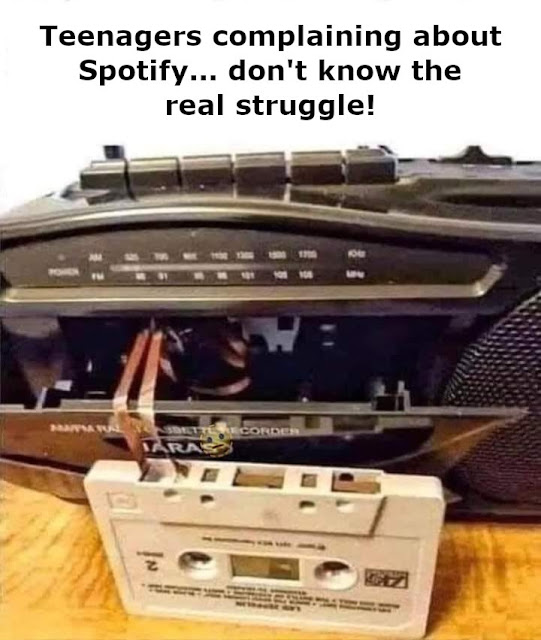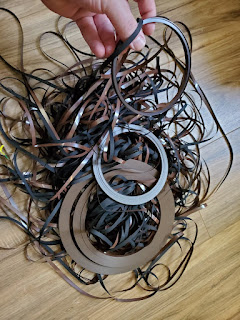The Broken 8-Track
- jim Young
“All broken things can be fixed. The hard part is deciding that they’re worth fixing.” - Jennifer Hartman
That’s kinda the problem with the world today. The more things become computerized, the less opportunity there is to fix them yourself.
As frustrating as it was to have your cassette player eat your favourite Beatles tape... at least it wasn’t a lost cause. The first step was to get the tape out of the player, preferably intact. But even if that wasn’t possible, your broken cassette tape could still be repaired with another kind of tape... Scotch Tape. The trick was to mend the cassette tape with the Scotch Tape on the side that didn’t pass directly over the heads of the player.
The creases and folds in the tape couldn’t be ironed smooth, but once the cassette tape was rewound tightly into the cassette using a pencil or bic pen, it was still usually playable. With the tape running at a speed of 1.875 inches per second, the 2 or 3 inches of crumpled pieces of tape passed over the play head in... well, seconds. Surprisingly the mangled piece of tape often didn’t cause that much disruption to the playback. The result was certainly no worse than a tick or a skip that we were well accustomed to in our vinyl days.
In the rare event the cassette had to be taken apart to rewind the tape, many were secured with small phillips screws making disassembly easy . Those that were glued could be split open with a razor blade and reassembled with glue.
But the real challenge was attempting to repair an 8-Track. If you were lucky, the tape would only have one or two feet pulled out of the cartridge. By holding the cartridge with your left hand, with the exposed tape hanging down, it was a matter of giving the right hand side of the loop a quick tug. As the single reel inside the cartridge spun, the reel would take up the left side of the loop more quickly than the right side gave it up. Repeating this procedure two or three times often saw the tape pulled back into position, safely inside the cartridge and ready to play, no worse for the wear.
More severe damage to the 8-Track tape however called for drastic measures that only the very determined would undertake. That was me. I was often one of the more determined.
It was the Summer of 1977. I was working as a disc jockey at Sugar’s Disco and living alone in a room in the Leonard Hotel in St. Catharines. Elvis had just died and the 8-Track player in my old beat up Rambler had eaten my “Frampton Comes Alive” 8-Track. I wasn’t about to lose both Elvis AND Frampton that summer.
But this was not a simple fix. Too much tape had been pulled from the cartridge and was split in two. It was obvious that the more simple method of repair would not work. 8-Track Cartridges were usually held together with a single screw in the middle, covered by the label and a plastic clip tab near the front of the cartridge. The screw was easy enough to remove by poking a screwdriver through the label but the clip tab, more often than not, ended up breaking when trying to open the cartridge.As the 8-Track system involved a loop tape, there was only a single reel inside. It spun in a clockwise direction with no reverse option. The neatly wound tape that pulled from the inside of the reel and returned to the outside of the reel, was no longer neatly wound. It was just a rat’s nest of magnetic tape.
I considered the garbage pail by my desk as my first option, but changed my mind and decided to accept the challenge which would require manually rewinding the tape in its entirety. The first course of action was to determine which side of the tape was inside and which was outside and then which side was up and which was down. I would have to ensure I would not lose sight of that perspective during the process as I had no interest in listeninging to “Frampton Comes Alive” played backwards with or without the assistance of LSD.The only way to properly replace the tape on the reel was to first remove it all and untangle it.
“Frampton Comes Alives” was a double album recording with 78.06 minutes of playing time that required more tape inside the cartridge than most 8-Tracks used at that time.
Traveling at a speed of 3.75” per second that equates to 1,463.625’ of tape required to pass by the heads.
Being that the tape consisted of 4 tracks of 2 stereo channels (ergo the name “8-Track”), that cut the actual footage of tape required down to about 365 feet that I had to untangle and stretch back and forth across the room, over my bed and across the dresser and desk.
Then came the tedious task of rewinding the tape back onto the spool. With the beginning circumference being about 3 inches and gradually increasing to an ending circumference of about 12” I’ll let you guess how many tedious revolutions of the spool by finger were required to wind 365 feet of tape back into place in the cartridge. Keep in mind that some degree of consistency to the tightness that the tape was rewound had to be maintained.
The tape then had to be reconnected with a slice of Scotch Tape and the cartridge resealed with the single screw and some airplane glue to make up for the broken clip tab.Then came the moment of truth. Holding my breath was substituted for the traditional drum roll as the 8-Track was inserted into the player in my car.
I have to mention here there was always a great deal more satisfaction in shoving an 8-Track into an 8-Track Player player to start your music than there ever was in gently dropping the tone arm of a record player onto vinyl or pressing a button to have the tray of a CD player slide into place.
And then the music started, giving me permission to breathe once more. In the middle of Track 3, Peter Frampton began singing “Jumpin’ Jack Flash” about 2 minutes and 20 seconds into the song. I hadn’t even considered dreaming that the tape would begin at the very start of any song or any track, much less Track One. That the tape was functioning at all and without warble was reward enough.
As long as it took me to repair that 8-Track tape that day, I still made it on time to start my show at Sugar’s Disco that night. And the first song I played was not Peter Frampton, but “Ain't Gonna Bump No More (With No Big Fat Woman)” by Joe Tex.
 |
| Sugar's Disco Booth The Leonard Hotel, St. Catharines Summer of 1977 |
While I was a Peter Frampton fan myself, the patrons of Sugar’s Disco in 1977 were still hard core disco fans. I can only hope some of them got better.
Yes, my friends... Those were the days.
- 30 -
Do you have some pictures or memories of the proverbial “good old days” that you would like to share? If so, please send them by clicking on this link, Those Were The Days, My Friend.








Comments
Post a Comment